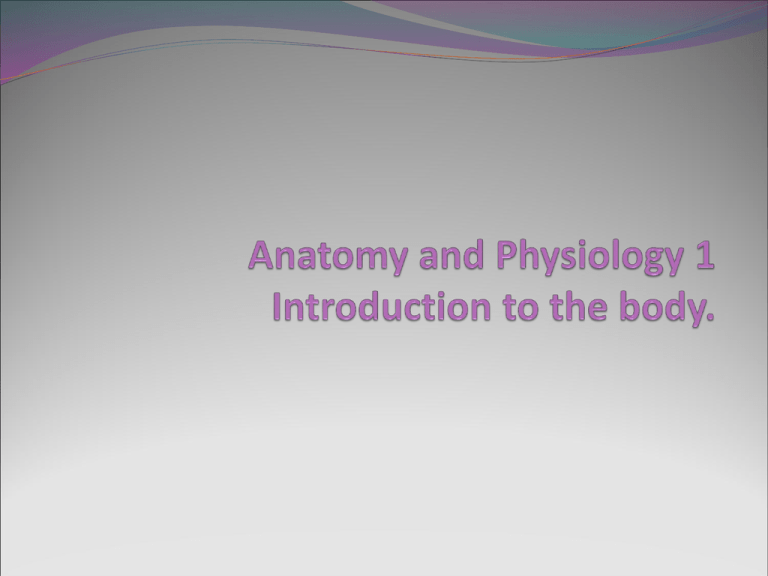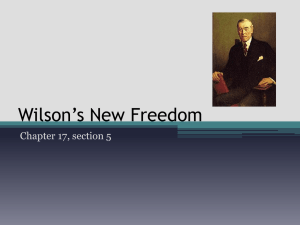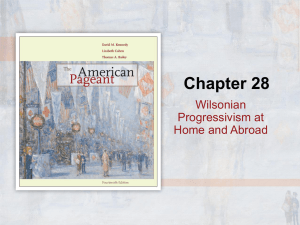
Welcome to Anatomy & Physiology
This subject is a complex and comprehensive look at the
body’s structure, how it fits in relation to other parts, and
how each organ basically works.
It will predominately focus on the macro scale, with a brief
introduction into cellular function.
What is expected of you is:
Dedication to complete the assessment tasks
To have an inquisitive mind to comprehend things that
cannot be easily seen.
To ask and explore questions to help you understand how the
organ is working to maintain health.
Comprehend how the body works as a whole, synergistically
Written by Leah Marmulla for use by AoCH (C)
2012 modified from Ross & Wilson 11th Ed.
Adapted for use by Eleshia Howell.Not to be used
without the expressed permission of the author.
2
By the end of the subject.....
You will be able to: Learning outcomes
Accurately use and describe medical and/or paramedical
terminology related to human anatomy and physiology and
associated health issues in the context of natural therapies
Explain the structure and functioning of the cells, tissues
and organ systems
Describe the major components of each body system and
their location in relation to other structures.
Explain the principles of functional anatomy in relation to
each body system
Written by Leah Marmulla for use by AoCH (C)
2012 modified from Ross & Wilson 11th Ed.
Adapted for use by Eleshia Howell.Not to be used
without the expressed permission of the author.
3
Explain the key factors necessary to healthy functioning of
each body system and interrelationships between body
systems to maintain overall health.
Explain common problems associated with each body
system.
Recognise variations from normal functioning and
determine an appropriate response in terms of:
Referral to an appropriate medical, nursing or allied health
professional - provision of appropriate health care services.
Refer to or seek assistance from an appropriate medical or
paramedical authority in relation to variations from normal
functioning.
Articulate scope of practice and boundaries for each
individual team member
Written by Leah Marmulla for use by AoCH (C)
2012 modified from Ross & Wilson 11th Ed.
Adapted for use by Eleshia Howell.Not to be used
without the expressed permission of the author.
4
Assessment Procedure
Your assessment will encompass a variety of activities, all
designed to allow you to show your level of understanding
and practical skills that you have developed over the period
of study and will be assessed in 3 ways:
Work book comprehensive questions and labeling to
display your understanding of each organ system. This
needs to be completed each week.
Final assignment detailing the interrelationship of organ
systems to maintain health and wellbeing.
In class exams.
Written by Leah Marmulla for use by AoCH (C)
2012 modified from Ross & Wilson 11th Ed.
Adapted for use by Eleshia Howell.Not to be used
without the expressed permission of the author.
5
Lets Get Started
Written by Leah Marmulla for use by AoCH (C)
2012 modified from Ross & Wilson 11th Ed.
Adapted for use by Eleshia Howell.Not to be used
without the expressed permission of the author.
6
Structure and Function
Anatomy
Describes the structures of the body
What they are made of
Where they are located
Associated structures
Physiology
Is the study of
Functions of anatomical structures
Individual and cooperative functions
Written by Leah Marmulla for use by AoCH (C) 2012 modified from Ross & Wilson 11th Ed. Adapted for
use by Eleshia Howell. Not to be used without the expressed permission of the author.
7
Anatomy and Physiology Integrated
Anatomy
Gross anatomy, or macroscopic anatomy, examines
large, visible structures
Surface anatomy: exterior features
Regional anatomy: body areas
Systemic anatomy: groups of organs working together
Developmental anatomy: from conception to death
Clinical anatomy: medical specialties
Written by Leah Marmulla for use by AoCH (C) 2012 modified from Ross & Wilson 11th Ed. Adapted for use by
Eleshia Howell. Not to be used without the expressed permission of the author.
8
Anatomy and Physiology Integrated
Anatomy
Microscopic anatomy examines cells and molecules
Cytology: study of cells and their structures
• cyt- = cell
Histology: study of tissues and their structures
Written by Leah Marmulla for use by AoCH (C) 2012 modified from Ross & Wilson 11th Ed. Adapted for use by
Eleshia Howell. Not to be used without the expressed permission of the author.
9
Anatomy and Physiology Integrated
Physiology
Cell physiology: processes within and between cells
Special physiology: functions of specific organs
Systemic physiology: functions of an organ system
Pathological physiology: effects of diseases
Written by Leah Marmulla for use by AoCH (C) 2012 modified from Ross & Wilson 11th Ed. Adapted for use
by Eleshia Howell. Not to be used without the expressed permission of the author.
10
Levels of Organization
section 1-5
The Chemical (or Molecular) Level
Atoms are the smallest chemical units
Molecules are a group of atoms working together
The Cellular Level
Cells are a group of atoms, molecules, and organelles
working together
The Tissue Level
Tissues are a group of similar cells working together
The Organ Level
An organ is a group of different tissues working together
Written by Leah Marmulla for use by AoCH (C) 2012 modified from Ross & Wilson 11th Ed. Adapted for use by
Eleshia Howell. Not to be used without the expressed permission of the author.
11
Levels of Organization
The Organ System Level
Organ systems are a group of organs working
together
Humans have 11 organ systems
The Organism Level
A human is an organism
Written by Leah Marmulla for use by AoCH (C)
2012 modified from Ross & Wilson 11th Ed.
Adapted for use by Eleshia Howell.Not to be used
without the expressed permission of the author.
12
Organism
Systems
Organs
Tissue
Cells
Chemistry
Written by Eleshia Howell for use by AoCH (C) 2012 Not to be used without the expressed permission
of the author.
13
Homeostasis
Homeostasis:
all body systems working together to maintain a stable
internal environment
Systems respond to external and internal changes to
function within a normal range (body temperature,
fluid balance, blood pressure etc)
Written by Leah Marmulla for use by AoCH (C) 2012 modified from Ross & Wilson 11th Ed. Adapted for use by
Eleshia Howell. Not to be used without the expressed permission of the author.
14
Homeostasis
Mechanisms of Regulation
Autoregulation (intrinsic)
Automatic response in a cell, tissue, or organ to some
environmental change
Extrinsic regulation
Responses controlled by nervous and endocrine systems
Homeostasis is maintained by control systems that detect and
respond to changes in the internal environment.
Written by Leah Marmulla for use by AoCH (C) 2012 modified from Ross & Wilson 11th Ed. Adapted for use by
Eleshia Howell. Not to be used without the expressed permission of the author.
15
The 3 basic components of these control
systems are: Receptor
Receives the stimulus
Control center
Processes the signal and sends instructions
Effector
Carries out instructions
Written by Leah Marmulla for use by AoCH (C) 2012 modified from Ross & Wilson 11th Ed. Adapted for use
by Eleshia Howell. Not to be used without the expressed permission of the author.
16
Fig 1.4 Example of negative feedback mechanism pg 6
Written by Leah Marmulla for use by AoCH (C) 2012 modified from Ross & Wilson 11th Ed. Adapted for use by
Eleshia Howell. Not to be used without the expressed permission of the author.
17
Negative and Positive Feedback
The Role of Negative Feedback
The response of the effector decreases or negates the
effect of the original stimulus, maintaining or restoring
homeostasis.
Body is brought back into homeostasis
Normal range is achieved
Written by Leah Marmulla for use by AoCH (C) 2012 modified from Ross & Wilson 11th Ed. Adapted for use by
Eleshia Howell. Not to be used without the expressed permission of the author.
18
FIGURE 1–4 Negative Feedback in the Control of Body Temperature. (Martini & Nath)
Written by Leah Marmulla for use by AoCH (C) 2012 modified from Ross & Wilson 11th Ed. Not to be used
without the expressed permission of the author.
19
The Role of Positive Feedback
Cascade or amplifier system to progressively increase the
response.
The response of the effector increases change of the
stimulus, speeding up the response.
Body is moved away from homeostasis
Normal range is lost
Eg. Blood clotting; child birth
Written by Leah Marmulla for use by AoCH (C) 2012 modified from Ross & Wilson 11th Ed. Adapted for use
by Eleshia Howell. Not to be used without the expressed permission of the author.
20
FIGURE 1–5 Positive Feedback: Blood Clotting. (Martini & Nath)
Written by Leah Marmulla for use by AoCH (C) 2012 modified from Ross & Wilson 11th Ed. Not to be used without
the expressed permission of the author.
21
Systems Integration
When all of the physiological systems work together to
maintain balance (homeostasis) .
When there is a break in this balance, disease or even
death may result.
Written by Leah Marmulla for use by AoCH (C) 2012 modified from Ross & Wilson 11th Ed. Adapted for
use by Eleshia Howell. Not to be used without the expressed permission of the author.
22
The organs and their corresponding systems.
Written by Leah Marmulla for use by AoCH (C)
2012 modified from Ross & Wilson 11th Ed. Not
to be used without the expressed permission of
the author.
23
Survival needs and related body activities.
Survival Need
Communication
Body Activities
Transport systems: blood, circulatory
system, lymphatic system.
Internal communication: nervous
system, endocrine system.
External communication: special
senses, verbal and non-verbal
communication.
Intake of raw materials & elimination of Oxygen; nutrition.
waste.
Urine, faeces, carbon dioxide.
Protection and survival
p8 Ross & Wilson
External environment = skin
Internal environment = immunity,
resistance
Body movement
Reproduction.
Written by Leah Marmulla for use by AoCH (C)
2012 modified from Ross & Wilson 11th Ed.
Adapted for use by Eleshia Howell.Not to be used
without the expressed permission of the author.
24
Includes
Communication
transport
Blood and lymphatics
communication.
Involves receiving, collating and responding to appropriate
information
Internal maintains homeostasis and regulates vital body
functions, includes:
endocrine
Nervous
External includes:
Special senses
Verbal & non – verbal communication
Written by Leah Marmulla for use by AoCH (C)
2012 modified from Ross & Wilson 11th Ed.
Adapted for use by Eleshia Howell.Not to be used
without the expressed permission of the author.
25
1. Transport
Blood – transports substances around the body via a
network of vessels (veins, arteries, capillaries). Blood
contains:
Plasma - high content of water + nutrients, oxygen,
hormones, cell waste products.
Blood cells – Red, white, clotting factors.
Heart – specialised muscle which pumps blood through
vessels to the entire body.
Lymphatic system – the body’s filtration system!
Vessels
Lymph fluid
Lymph nodes
Lymph organs / tissue
Written by Leah Marmulla for
use by AoCH (C) 2012. Adapted for use by
Eleshia Howell.Not to be used without the
expressed permission of the author.
26
2. Internal Communication
NERVOUS SYSTEM:
Central Nervous System (CNS)
Brain and spinal cord
Peripheral Nervous System (PNS)
Sensory (afferent) nerves – transmit
signals from the body to the brain
Motor (efferent) nerves – transmit
from the brain to effector organs eg
muscle.
Written by Leah Marmulla for use by AoCH (C)
2012 modified from Ross & Wilson 11th Ed.
Adapted for use by Eleshia Howell.Not to be used
without the expressed permission of the author.
27
Somatic/common senses
Pain
Touch
Heat
Cold
- Arise from stimulation of specialised sensory
receptors at nerve endings located in the skin.
Written by Leah Marmulla for use by AoCH (C)
2012 modified from Ross & Wilson 11th Ed.
Adapted by Eleshia Howell. Not to be used
without the expressed permission of the author.
28
Neural
Communication
29
Internal Communication Endocrine System
Discrete glands situated in different
parts of the body.
Synthesise and secrete chemical
messengers – hormones, which
circulate through the blood.
Hormones are made in one part of
the body and effect a specific target
glands or tissue else where,
influencing metabolism, and
regulating bodily functions.
Endocrine glands operate via
biofeedback system, to monitor
Written by Leah Marmulla for use by AoCH (C)
2012 modified from Ross & Wilson 11th Ed.
and respond to homeostatic
Adapted by Eleshia Howell. Not to be used
changes.
without the expressed permission of the author.
30
3. External Communication
Special Senses – sight, smell, hearing, taste, balance.
Verbal communication – speech, sound
Non- verbal communication – posture, body language,
facial expression.
Written by Leah Marmulla for use by AoCH (C)
2012 modified from Ross & Wilson 11th Ed.
Adapted by Eleshia Howell. Not to be used
without the expressed permission of the author.
31
Ingestion & Elimination
INTAKE OF OXYGEN:
Respiratory system
Upper
Above the pharynx
Lower systems
lungs
Bronchial tubes
Alveoli
Written by Leah Marmulla for use by AoCH (C)
2012 modified from Ross & Wilson 11th Ed.
Adapted for use by Eleshia Howell.Not to be used
without the expressed permission of the author.
32
INGESTION OF NUTRIENTS
Digestive system
Several organs are involved.
Each has a separate role in the
digestion of food , absorption,
assimilation of the nutrients
Nutrients are grouped as Macro:
- Carbohydrates (CHO)
- Proteins
- Fats
- Water
- Fibre
or Micro nutrients – vitamins,
minerals & EFA
Written by Leah Marmulla for use by AoCH (C)
2012 modified from Ross & Wilson 11th Ed.
Adapted for use by Eleshia Howell.Not to be used
without the expressed permission of the author.
33
Nutrients are vital to maintaining functional
homeostasis
Maintenance of water balance
Energy production,
Synthesis of large and complex molecules
Cell building, growth and repair
Metabolism – the sum total of chemical activity in the
body
Anabolism - building or synthesis of large and complex
substances
Catabolism – breaking down substances to provide
energy and raw materials for anabolism and substances
for excretion as waste.
Written by Leah Marmulla for use by AoCH (C)
2012 modified from Ross & Wilson 11th Ed. Not
to be used without the expressed permission of
the author.
34
Elimination
Carbon dioxide – lungs
Helps to maintain pH
Urine – kidneys and
associated organs
Water and water soluble
products
Regulates fluid balance
Blood pH
Large intestine
Faecal matter
Indigestible good residue
that can not be absorbed
Bile from liver and fat
soluble wastes
Bilirubin from RBC
recycling
Microbes/bacteria
Written by Leah Marmulla for use by AoCH (C)
2012 modified from Ross & Wilson 11th Ed. Not
to be used without the expressed permission of
the author.
35
Protection & Survival
Protection against:
external environment - skin
Infection - immunity
Movement – essential for activities but also
avoiding injury, reproduction etc. Reflexes.
Survival of the species:
Transmission of inherited characteristics
reproduction
Written by Leah Marmulla for use by AoCH (C)
2012 modified from Ross & Wilson 11th Ed.
Adapted for use by Eleshia Howell.Not to be used
without the expressed permission of the author.
36
Summary...
This section has provided an overview of Chapter 1 in
your Ross & Wilson textbook.
Chapter 2, Intro to Chemistry of Life, will be covered
in another Subject (Biochem ??).
We will now begin to look at Chapter 3...starting with
the building blocks of life....the CELL!
Written by Eleshia Howell for use by AoCH (C)
2012. Not to be used without the expressed
permission of the author.
37
The Human Cell
Written by Eleshia Howell for use by AoCH (C)
2012. Not to be used without the expressed
permission of the author.
38
Cells are the building blocks of all plants and animals.
All cells come from the division of pre-existing cells.
Cells are the smallest units that perform all vital
physiological function
Each cell maintains homeostasis at the cellular level.
Cells are surrounded by a plasma membrane, or cell
membrane, and filled with intracellular fluid
(cytoplasm).
Written by Eleshia Howell for use by AoCH (C)
2012 .Not to be used without the expressed
permission of the author.
39
Types of Cells...
Sex Cells (Germ cells) = Reproductive cells
Spermatazoon (Male)
Zygote
Oocytes (Female)
Somatic Cells (soma = body)
All other cells within the body.
Written by Eleshia Howell for use by AoCH (C)
2012 modified from Ross & Wilson 11th Ed. Not
to be used without the expressed permission of
the author.
40
The Anatomy of a Cell...
Plasma Membrane – the cell wall
Cytoplasm – liquid suspension for cell contents
Organelles – tiny organs of specialised function
within the cell.
Nucleus – contains the genetic material of cell
Let’s take a look at these structures individually...
Written by Eleshia Howell for use by AoCH (C)
2012 modified from Ross & Wilson 11th Ed. Not
to be used without the expressed permission of
the author.
41
Plasma Membrane
see Figure 2.2, p29 Ross & Wilson.
© Eleshia Howell 2012. AoCH.
42
Consists of two layers of phospholipids, with protein,
sugar (Carbs) and cholesterol molecules embedded
within.
The proteins perform several functions:
- provide transport channels across the cell membrane
- provide immunologic identity
- can act as receptors for hormones or other chemical
messengers
- may act as enzymes (catalysts for chemical reactions)
- help to stabilise the structure of plasma membrane
Cell wall provides structure & regulates activity of cell
Written by Eleshia Howell for use by AoCH (C) 2012 modified from Ross & Wilson 11th Ed. Not to be
used without the expressed permission of the author.
43
Cytoplasm
All materials inside the cell and outside of the Nucleus
Cytosol:
Fluid filled with dissolved nutrients, ions, proteins and
waste products.
Organelles:
Tiny organs within the cell that perform specialised
functions.
Written by Eleshia Howell for use by AoCH (C)
2012 modified from Ross & Wilson 11th Ed. Not
to be used without the expressed permission of
the author.
44
Organelles
Subdivided into two categories...
1. Membranous – covered in a plasma membrane to
isolate them within the cytosol.
These include:
Endoplasmic Reticulum (ER)
Golgi apparatus
Lysosomes
Peroxisomes
Mitochondria
Written by Eleshia Howell for use by AoCH (C) 2012 modified from Ross & Wilson 11th Ed. Not to be
used without the expressed permission of the author.
45
2. Non-membranous – no membrane, therefore have
direct contact with cytosol.
These include:
Cytoskeleton
Microvilli
Centrioles
Cilia
Ribosomes
Proteasomes
Written by Eleshia Howell for use by AoCH (C)
2012 modified from Ross & Wilson 11th Ed. Not
to be used without the expressed permission of
the author.
46
The Nucleus
Every cell in the body (except mature RBC’s) contains a
Nucleus....some, such as skeletal muscle cells, contain
many nuclei.
It is the largest of the organelles and is contained within
its own membrane (nuclear envelope) allowing selective
permeability. Has own fluid – nucleoplasm.
Contains the body’s genetic material (46 chromosomes
– DNA!)
Nucleolus involved in manufactures and assembly of
ribosome components.
Written by Eleshia Howell for use by AoCH (C) 2012 modified from Ross & Wilson 11th Ed. Not to be
used without the expressed permission of the author.
47
Written by Eleshia Howell for use by AoCH (C)
2012 .Not to be used without the expressed
permission of the author.
48
Mitochondria
p29 Ross & Wilson
Smooth outer body with inner folded membrane
(cristae)....look like a peanut!
Often described as the “powerhouse” of the cell
Responsible for energy production - via aerobic
respiration, the mitochondria take chemical energy
from food (carbohydrates) and convert to a substance
called ATP. When the cell breaks down this ATP
molecule, energy is released for cellular activity.
The more active the cell, the more mitochondria are
present.
Written by Eleshia Howell for use by AoCH (C)
2012 modified from Ross & Wilson 11th Ed. Not
to be used without the expressed permission of
the author.
49
Written by Eleshia Howell for use by AoCH (C)
2012. Not to be used without the expressed
permission of the author.
50
Ribosomes
p29 Ross & Wilson
Tiny granules of RNA and protein
Synthesize proteins from amino acids, either for use IN
the cell (Free ribosomes will be found in the
cytoplasm) or to export FROM the cell (Fixed
ribosomes will be found on the rough endoplasmic
reticulum).
Written by Eleshia Howell for use by AoCH (C) 2012 modified from Ross & Wilson 11th Ed. Not to be
used without the expressed permission of the author.
51
Endoplasmic Reticulum (ER) p30
An extensive series of interconnecting membranous
canals in the cytoplasm.
Two types....smooth and rough
Smooth ER – synthesizes lipids and steroid hormones
and helps to detoxify some drugs / medications. The
lipids may be used to repair / replace membranes of
the cell and organelles.
Rough ER – covered in Ribosomes; active in protein
synthesis; encloses substances in transport vesicles
ready to send to Golgi Apparatus.
Written by Eleshia Howell for use by AoCH (C) 2012 modified from Ross & Wilson 11th Ed. Not to be used
without the expressed permission of the author.
52
Written by Eleshia Howell for use by AoCH (C) 2012. Not to be used without the expressed permission of
the author.
53
Golgi Apparatus p30 Ross & Wilson
Stacks of closely folded membranes, looks like a
flattened sac.
Present in all cells but appears larger in cells
responsible for synthesizing and exporting proteins.
Proteins move from E.R to Golgi where they are
packaged into small vesicles (secretory granules) to be
stored until needed.
Written by Eleshia Howell for use by AoCH (C) 2012 modified from Ross & Wilson 11th Ed. Not to be used
without the expressed permission of the author.
54
55
Lysosomes
A type of secretory vesicle formed by the Golgi
apparatus, containing a variety of enzymes involved in
breaking down fragments of organelles and other large
molecules within the cell, eg. carbohydrates, proteins,
DNA, into smaller molecules that can either be
recycled or expelled as waste material.
Lysosomes in White Blood Cells contain enzymes that
digest foreign material, such as microbes.
Written by Eleshia Howell for use by AoCH (C) 2012 modified from Ross & Wilson 11th Ed. Not to be used
without the expressed permission of the author.
56
Peroxisomes
Smaller than Lysosomes and carry a different group of
enzymes to absorb and break down fatty acids, other
organic compounds and toxic substances.
The by-product of this process is Hydrogen Peroxide, a
potentially dangerous free radical.
Other enzymes within the Peroxisome then break
down the H2O2 into oxygen and water, thus protecting
the cell.
Metabollically active tissue, such as Liver cells, are high
in peroxisomes.
Written by Eleshia Howell for use by AoCH (C) 2012. Not to be used without the expressed permission of
the author.
57
Cytoskeleton
An extensive network of protein fibres
provides structure to the internal contents of the cell
Responsible for the movement of the cell with tissue
Assists in cell division (cytokinesis)
Contains:
Microfilaments
Microtubules
Centrosome
Cell extensions – microvilli, cilia, flagella
Written by Eleshia Howell for use by AoCH (C) 2012. Not to be used without the expressed permission of the
author.
58
59
Microfilament:
The smallest fibres within the cytoskeleton
Provide structure and support
Maintain the shape of the cell
Allow contraction, eg muscle cell
Microtubules:
Larger contractile fibres involved in the movement of
organelles within the cell, chromosomes during cell
division and cell extensions.
Written by Eleshia Howell for use by AoCH (C) 2012 modified from Ross & Wilson 11th Ed. Not to be used
without the expressed permission of the author.
60
Centrosome:
Directs the organisation of microtubules within the
cell
Consists of a pair of centrioles (small clusters of
microtubules)
Plays an important role in cell division.
Cell Extensions:
Projections from the plasma membrane that improve
the function or provide movement for the cell.
3 types...
Written by Eleshia Howell for use by AoCH (C) 2012 modified from Ross & Wilson 11th Ed. Not to be used
without the expressed permission of the author.
61
Microvilli – tiny projections that contain
microfilaments. Predominantly cover cells whose
main function is absorption, eg small intestine.
2. Cilia – microscopic hair-like projections which move
in unison to create movement of substances along
the surface of the cell, eg mucous membranes in
respiratory tract.
3. Flagella – single, long, whip-like “tails” that enable
movement, eg sperm.
1.
Written by Eleshia Howell for use by AoCH (C) 2012 modified from Ross & Wilson 11th Ed. Not to be used without
the expressed permission of the author.
62
Life cycle of a Cell
Written by Eleshia Howell for use by AoCH (C) 2012 modified from Ross & Wilson 11th Ed. Not to be used
without the expressed permission of the author.
63
Damaged, dead and worn out cells can be replaced by
growth and division of other similar cells
Most of our body cells have 46 chromosomes and divide
by a process called MITOSIS, which results in two
genetically identical daughter cells.
The exception being sex cells (Gametes) such as sperm
and ova, which occurs through MEIOSIS.
Written by Eleshia Howell for use by AoCH (C) 2012 modified from Ross & Wilson 11th Ed. Not to be used
without the expressed permission of the author.
64
The period between two cell divisions is called the cell
cycle ( see p31 Ross & Wilson) and it has two distinct
phases: Mitosis (known as the ‘M’ Phase) and
Interphase.
Interphase:
The longest phase, separated into 3 stages...
1. G1 – the first gap phase, when the cell grows in size
and volume. The time frame varies for this phase and
in some instances, can even enter a ‘resting phase’.
Written by Eleshia Howell for use by AoCH (C) 2012 modified from Ross & Wilson 11th Ed. Not to be used
without the expressed permission of the author.
65
2. Synthesis of DNA ( ‘S’ phase) – the chromosomes
replicate, forming a duplicate set.
3. Second Gap Phase (G2) – further growth and
preparation for cell division.
Mitosis: Four distinct phases...
1. Prophase – the replicated chromatin becomes tightly
coiled. Each of the 46 chromosomes will pair up with
their duplicate copy to form a double chromosome
unit (chromatid). The centrioles begin to connect to
microtubules known as mitotic spindles and migrate
to each end of the cell. Nuclear envelope disappears.
Written by Eleshia Howell for use by AoCH (C) 2012 modified from Ross & Wilson 11th Ed. Not to be used
without the expressed permission of the author.
66
2. Metaphase – Chromatids align on the centre of the
spindle.
3. Anaphase – Centromeres separate, and one of each
pair of chromosomes migrates to one side of the cell.
The spindles contract to help pull them apart.
4. Telophase – The spindle disappears now, the
chromatid uncoils (leaving the chromosomes free) and
a new nuclear envelope appears around them.
Now cytokinesis fully occurs as the cytoplasm, organelles
and plasma membrane totally splits to form two
identical cells.
See p 32 Ross and Wilson for diagram of cell division.
Written by Eleshia Howell for use by AoCH (C) 2012 modified from Ross & Wilson 11th Ed. Not to be used
without the expressed permission of the author.
67
Transport of Substances across
cell membranes.
Cell membranes have selective permeability...not all
substances can cross through.
Those that can, do so in different ways, depending on
the size of the molecules and their individual
characteristics.
Written by Eleshia Howell for use by AoCH (C) 2012 modified from Ross & Wilson 11th Ed. Not to be used
without the expressed permission of the author.
68
Concentration Gradient
Substances will always travel from an area of HIGH
concentration to one of LOW concentration, unless there
is a barrier to prevent this from happening.
Moving down the concentration gradient until both sides
are equal is known as PASSIVE transport
Moving up the concentration gradient is known as
ACTIVE transport.
Check out this simple video to help you understand...
http://www.youtube.com/watch?v=1ZFqOvxXg9M&feature
=related
Written by Eleshia Howell for use by AoCH (C)
2012 modified from Ross & Wilson 11th Ed. Not
to be used without the expressed permission of
the author.
69
Other ways that substances can move across the cell
membrane are:
Diffusion
Facilitated diffusion
Osmosis
Bulk transport
Definitions can be found in Chapter 2, p25, as well as
Chapter 32-33.
Written by Eleshia Howell for use by AoCH (C) 2012 modified from Ross & Wilson 11th Ed. Not to be used
without the expressed permission of the author.
70
Free time to review topics covered or to
spend time on workbooks.
71









